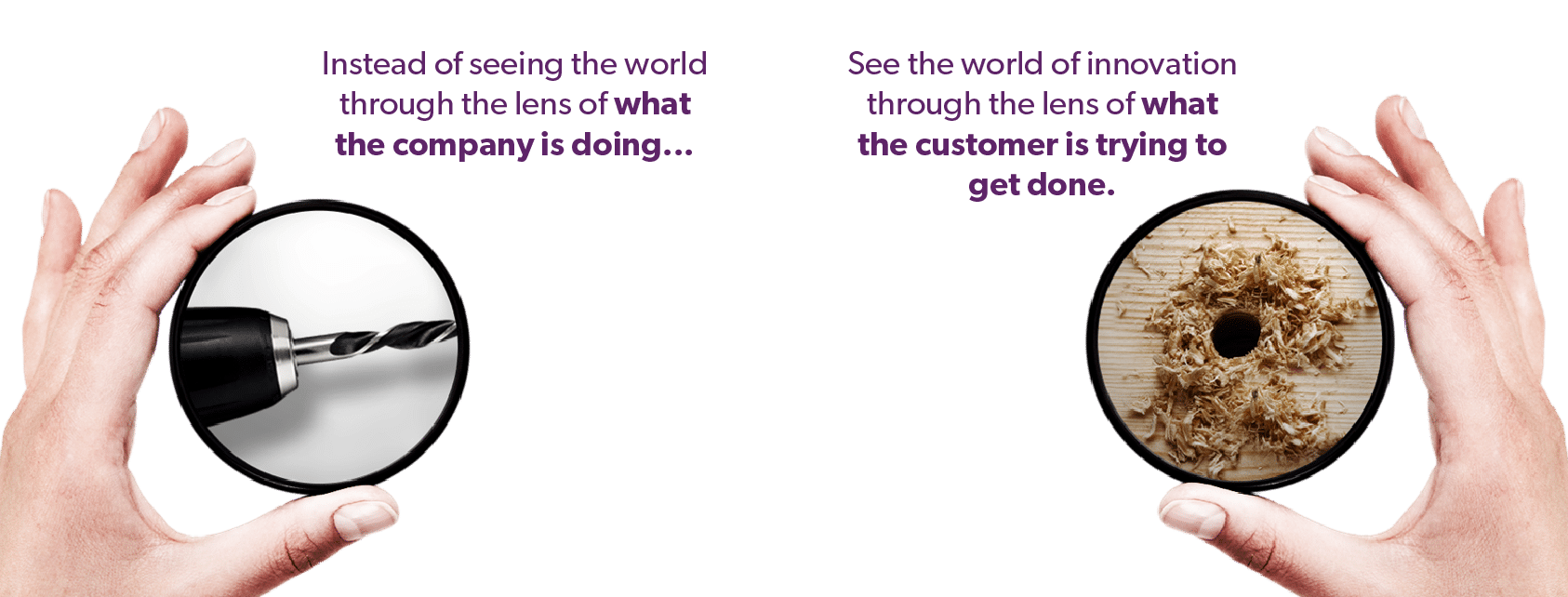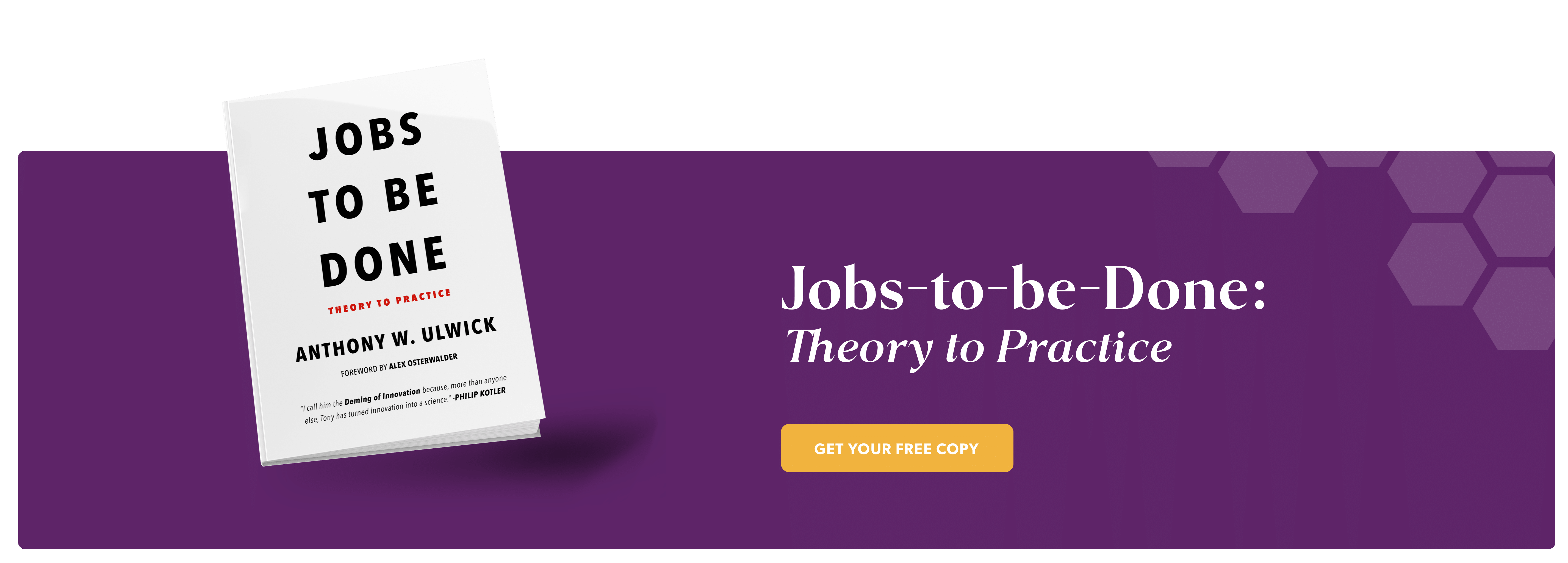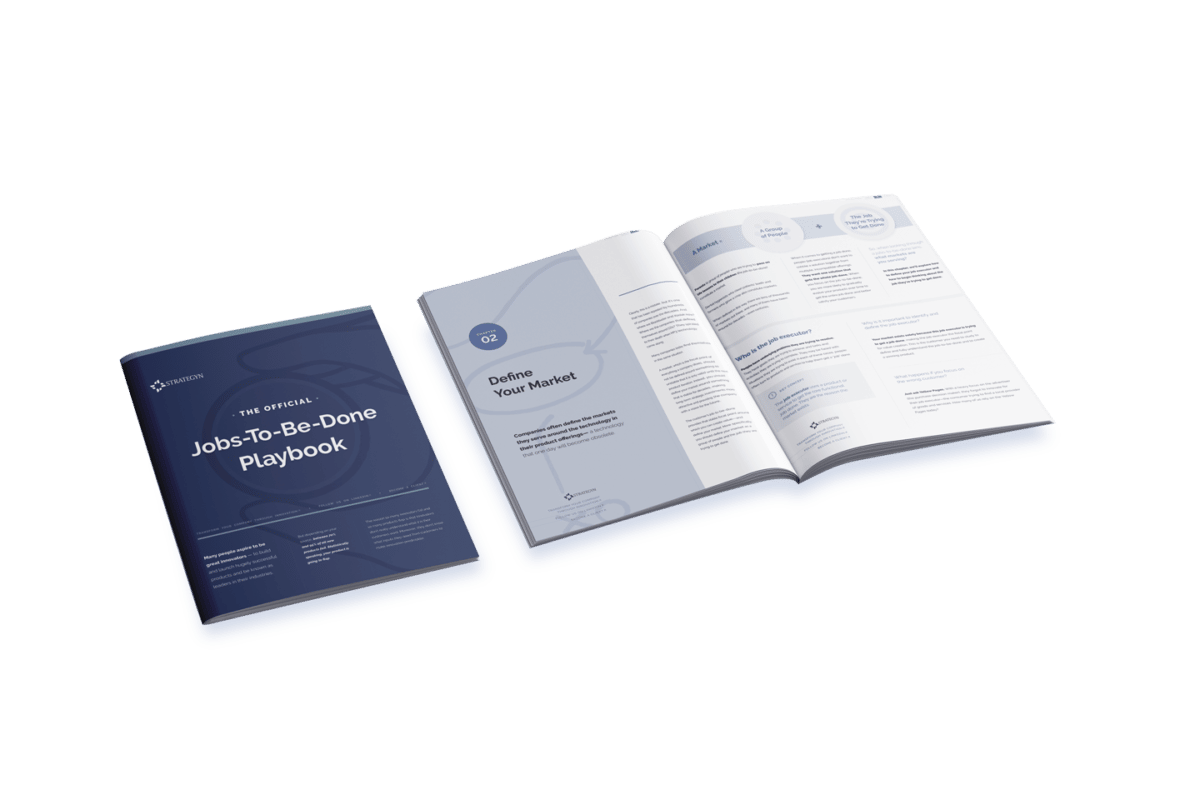We’ve all heard the Theodore Levitt quote about the quarter inch drill vs. the quarter inch hole — and for good reason. Incorporating your customer’s Job-to-be-Done into your product development process brings a lot of benefits.

For example:
But how do you make it happen?
Of course, step-by-step instructions can help. But detailed Jobs-to-be-Done examples really bring the concepts to life. We’ll cover both in this post, so you can confidently incorporate Jobs-to-be-Done Theory into your innovations.

Jobs-to-be-Done (JTBD) is best defined as a perspective — a lens that lets companies understand, with precision, why customers buy a product or service. Applying this lens to your innovation process allows you to clearly define what people are trying to accomplish when using any product or service (their job-to-be-done) and how they measure success.
This solution-agnostic insight opens new opportunities for innovation by providing clear instructions on how to help customers get their job done better — which makes innovation far more predictable and profitable.
The first step to applying this new Jobs-to-be-Done perspective to your innovation and product development process is to create a job statement. A job statement defines what the customer is using your product or service to accomplish, and it serves as the foundation for exploring how to help customers get the job done better. Examples of Jobs-to-be-Done, written as job statements, include:
Before you dive into drafting your own, you should get familiar with what makes an effective job statement. There are three important rules to follow.
You need to think about the job from the customer’s perspective, not the company’s. The job statement describes what customers are trying to accomplish when using a product. It should NOT describe what they are doing to complete that job-to-be-done. For example, a company that supplies herbicides to farmers may conclude that growers are trying to “kill weeds,” but that is what the farmers are doing, not what they are trying to accomplish. Killing weeds may be the main function of the herbicide product, but it’s not the farmer’s JTBD. From the grower’s perspective, they might say their job is to “prevent weeds from impacting crop yields.” This is what they are trying to achieve by killing weeds. To avoid this mistake, don’t ask “What job does my product do?” Instead, ask, “What job is the customer trying to get done when using the product?” Because customers often cobble together many solutions to get the entire job done, the answers to these two questions are often very different. We see many jobs-to-be-done examples in the blogosphere that get this wrong. Again, what people are DOING is not the same as what they are trying to accomplish.
Innovation is all about helping your customer to get their job done better. But core jobs-to-be-done often come with associated emotional and social jobs, and it’s easy to get that core, functional job confused with the emotional jobs. When it comes to writing effective job statements, you need to focus on the functional job-to-be-done. For example, a company that offers a product that “prevents people from getting lost when driving” would do themselves a disservice to conclude that their customers are hiring their product to “achieve peace of mind”. Focusing on “peace of mind” will not deliver the insight needed to better prevent people from getting lost (the functional job-to-be-done). Knowing the customers’ accompanying emotional jobs is helpful for positioning and messaging — not product innovation.
To properly define your customer’s Job-to-be-Done, you need to think big enough to encompass the entire job, not just a piece of it. A narrow focus will limit your innovation opportunities because customers are looking for products and services that help them get the entire job done better. For example, that company selling herbicides could focus on helping the grower “prevent weeds from impacting crop yields.” But thinking a bit bigger, they may want to consider helping farmers complete the entire job of “growing a crop”. Customers do not want to cobble many incompatible solutions together to get the entire job done. They prefer to get the entire job done on a single platform.
Let’s say a product manager at a bank is tasked with developing a new online checking account (a solution) for customers.
The first step would be to understand the "job" that customers are trying to complete with a checking account: manage daily cash flow. With this understanding, the product manager and team could conduct market research to uncover:
With this insight, the team could design a set of tools and resources to accompany the new checking account that would help customers fill the most critical gaps in the process of managing daily cash flow — and cut unnecessary features.
The product manager might therefore decide to incorporate a budgeting tool, alerts for low balances, reminders to deposit money or pay bills, etc. But she may decide to eliminate the peer-to-peer payment system that added overhead but just couldn’t compete with the established players like Paypal and Venmo.
A real-world Jobs-to-be-Done example in financial services comes from a Strategyn client that offers tax preparation software. They believed their customers were completing the job preparing clients’ taxes. But after talking to tax preparers, CPAs, and tax attorneys, they realized tax prep is only a small part of their business. Their real job is to devise and implement tax strategies for their clients—tax preparation is a small piece of the larger job.
With a broader look at the market, this company is rethinking its offering and coming up with new solutions to help these customers get more of the job done.
This time, our product manager works at a medical device company and is tasked with developing a new device for monitoring blood pressure.
(Remember, monitoring blood pressure is what the product does — not what the customer is trying to accomplish.)
When the product manager examines the situation through the JTBD framework, she realizes customers are monitoring their blood pressure to manage hypertension.
She then researches:
With this insight, the product manager and team may decide their blood pressure monitor must be easier to use (according to customer specifications), and customers need to feel more confident that results are accurate.
They may also decide to create an accompanying app that helps users track their blood pressure over time, alerts users to any unusual spikes or drops, and provides lifestyle tips for managing hypertension. This app would provide a more comprehensive solution that helps customers complete more of their job of managing hypertension.
Cordis Corporation gives us a real-world JTBD example in the medical device industry. Cordis was struggling to survive in the angioplasty balloon market. They discovered a dozen customer needs that were underserved by existing solutions — and created products to address them. Cordis released 19 new products, all of which became number 1 or 2 in the market, and their market share increased from 1% to over 20%.

Our example product manager moves jobs a lot and is now working with a software company. She’s tasked with developing a new app that helps manufacturers select parts suppliers and source parts for products.
Well-versed in JTBD by now, the product manager defines the job as find a supplier for a needed product or service. She digs into the research to discover that customers struggle with searching for and finding the correct parts for their projects within extensive part libraries.
Our product manager and team therefore design an app with top-quality search functionality, a variety of ways to filter and sort parts (industry, application, etc.), and an AI-driven part recommendation engine.
A stellar, real-world JTBD example comes from Cox Automotive’s vAuto division. vAuto offers auto dealers SaaS solutions to better manage their inventory. The team had already discovered the most obvious opportunities for product innovation — and needed to find the not-so-obvious opportunities to keep ahead of their competitors. Their research uncovered specific segments of their customers that were struggling with the job of managing dealership inventory more than others, and they used this insight to redefine their product roadmap.
The result was a 20X increase in their product install base.
The project had a significant financial impact to the vAuto business. Today, we have about 4,000 clients using the solution, a lot of which I attribute to the work we did with Strategyn to help us understand how to position the product properly and how to innovate and add value.

There are a few questions you should ask yourself to get into the mindset of your customers and help you determine their JTBD.
Consider your answers to the following:
These progressive questions will help you shift your mindset from your company's solution space into the customer’s problem space — the domain of the Job-to-be-Done.
If you’re finding it difficult to get into the mindset of your customer, don’t worry. This is a challenging process that takes time and practice.
A couple of tips to make to get you started:
Don’t try to create job statements that are too broad. While you want to think big enough to encompass the entire job-to-be-done, you should stay away from statements like “My product is for everyone.” Focus on a single job executor and attempt to see the world through their eyes. Figure out what they’re trying to accomplish when they use your product.
Be careful not to confuse job statements with product features and benefits. A job statement provides insight into the problem being solved, while a product feature lists the tangible aspects of a product (its functionality) that customers can see and touch. Stay focused on the job.

Where does the Jobs-to-be-Done Framework go from there? Check out our JTBD playbook for a deeper dive into applying JTBD to your innovation process:
Copyright ©2024 Strategyn LLC. All Rights Reserved. | XML Sitemap | HTML Sitemap